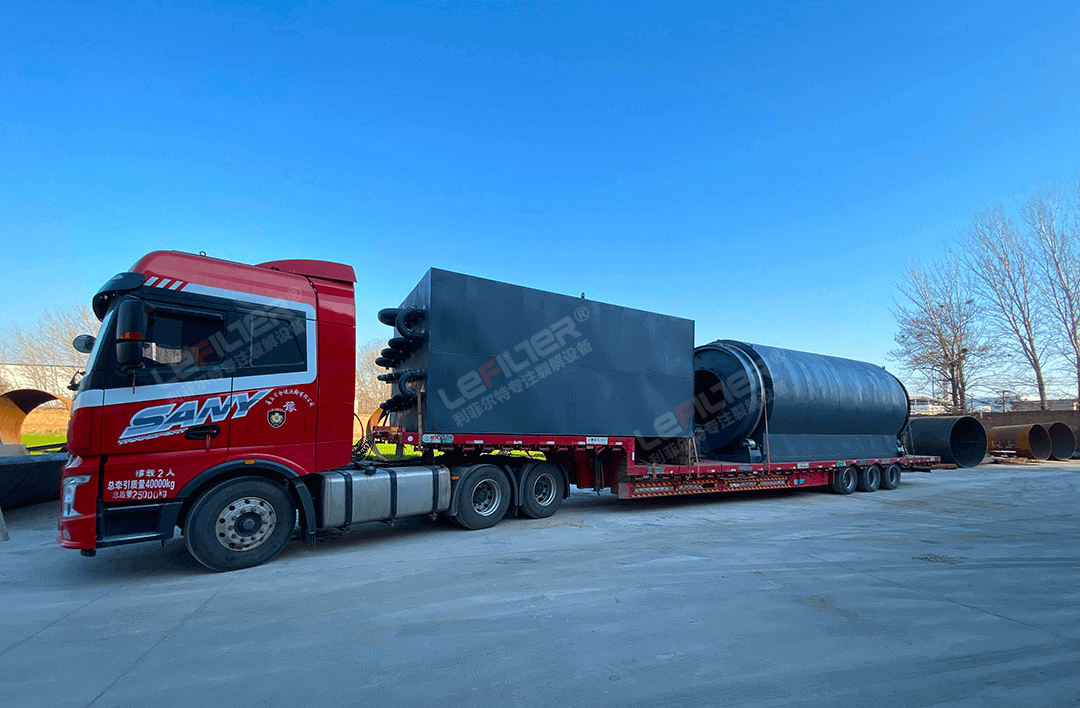Detailed explanation of waste tire pyrolysis process
The thermal pyrolysis of waste tires refers to the process of breaking macromolecules with unsaturated bonds in the main chain of rubber under anaerobic or anoxic working conditions and appropriate temperatures. The products are mainly monomers, dimers and fragments, and the products are polymerized into various olefins to remove volatile substances and form solid carbon. The products are mainly cracked oil and gas, coarse carbon black and steel wire.
The waste tire refining equipment adopts the micro negative pressure low temperature anoxic thermal pyrolysis process. The surface quality, insulation layer thickness and sealing performance of the equipment can meet the environmental requirements. The inlet and outlet of the pyrolysis furnace and the pipe connection are equipped with graphite roots, graphite gaskets and other parts, which are replaced regularly. The pipeline, slag removal system, oil storage tank, etc. are all fully enclosed equipment. The whole pyrolysis process is closed, and there will be no fugitive emission and leakage of flue gas during the pyrolysis process.
Brief introduction of tyre pyrolysis
Intermittent waste tire refining mainly selects the tires used by cars as the raw materials of waste tires. Before feeding, there is no pre-treatment section. Tires do not need to be cleaned, broken, drawn steel wire and other pre-treatment processes. They directly enter the pyrolysis furnace under the action of hydraulic loader. The feeding process is highly automated, safe, convenient, time-saving and labor-saving. As the pyrolysis process is a complex physical and chemical reaction process, its pyrolysis process is divided into multiple stages. The following is introduced in sections according to the pyrolysis reaction temperature.
Introduction to pyrolysis process
01.pyrolysis temperature range 0~100℃stage

When the pyrolysis temperature range is 0-100℃, open the equipment vent valve to slowly exhaust the air in the pyrolysis furnace, so as to realize the oxygen free condition in the pyrolysis process. Since the pyrolysis process has just started, the waste wheels need to be heated slowly at this stage, generally at a rate of 2K/min, and close the vent valve when the temperature reaches about 120℃. At this time, it will be found that the temperature in the furnace will be maintained for a period of time, and there will be no significant temperature rise, indicating that the waste tires begin to absorb a lot of heat, the pyrolysis reaction process gradually begins, and the production of pyrolysis non condensable gas begins. This stage is generally about 2 hours.
02.pyrolysis temperature range 150-380℃ stage

The three-dimensional network structure of the rubber in the tire was destroyed, and the lemon gum gradually cracked from chain macromolecules into low hydrocarbon molecules with small molecular weight in the form of gas phase. Especially when the temperature in the pyrolysis furnace reaches above 200℃, the gas phase pyrolysis products begin to be stably generated in the furnace. The larger molecules of C5 and above are condensed into pyrolysis oil and sent to the oil storage tank. The uncondensed pyrolysis gas is mainly C1-C4 light hydrocarbon gas with high calorific value, which can be used as heating fuel for pyrolysis furnace after being treated by pre desulfurization device. In order to ensure that the temperature in the pyrolysis furnace reaches 380℃, the control temperature of the pyrolysis furnace combustion chamber is 900-1100℃. In order to prevent the pyrolysis non condensable gas from burning too fast, resulting in too high heating rate and too violent pyrolysis process, the flow of the pyrolysis non condensable gas must be controlled to keep the temperature rising slowly, which generally takes about 4 hours.
03.pyrolysis temperature range 380 ℃constant temperature reaction stage
The pyrolysis process in this stage is similar to that in the second stage, and the above process is still carried out, which generally takes about 2 hours.

04.cooling
The carbon black decomposed during the pyrolysis process and the steel wire in the tire are stored in the pyrolysis furnace. After the furnace body stops heating, turn off the motor and power supply of the pyrolysis furnace. The project adopts natural air cooling, and the cooling section lasts about 8 hours. When the furnace body is cooled to 120℃, start the carbon black screw conveyor to collect pyrolytic carbon black. After the carbon black is collected, open the vent valve above the furnace to introduce air, restore the normal pressure in the furnace, open the tank, and automatically unload the pyrolysis steel wire under the effect of the spiral on the furnace wall. This phase generally takes about 4 hours. Then fill new waste tires, and then carry out the above pyrolysis process.

05.Slagging of steel wire and carbon black
The pyrolysis furnace is equipped with steel wire outlet and carbon black outlet respectively. After the pyrolysis furnace cools down, open the steel wire outlet to discharge the steel wire. Since the tire is a whole tire when feeding, and there is no cutting and crushing section, the furnace body keeps rotating during the pyrolysis process, so the steel wire is twisted together when discharging, and a small amount of carbon black on the steel wire can be dropped by tapping. The steel wire is directly packaged and transported after discharging.
After the steel wire discharging is completed, close the steel wire mouth and open the carbon black discharging mouth (about 0.4m in diameter) to connect with the closed spiral slag extractor for carbon black discharging. During discharging, the screw slag extractor is closely connected with the carbon black outlet, the slag outlet of the slag extractor is directly connected with the packaging bag on the scale, and the carbon black is directly packaged in the packaging bag for sale after discharging, and the iron removal and grinding process can also be carried out to improve the utilization value of carbon black.
 Mobile/Wechat/Whatsapp:+86-13523737997
Mobile/Wechat/Whatsapp:+86-13523737997
 Email:recycling@lefilter.com
Email:recycling@lefilter.com 












